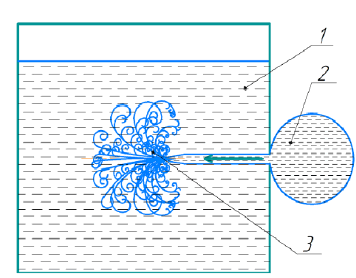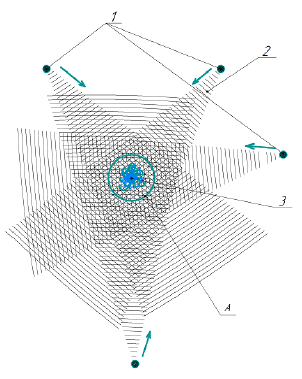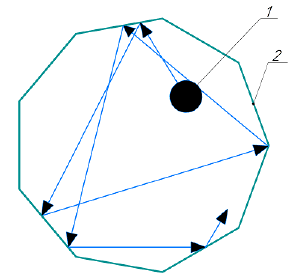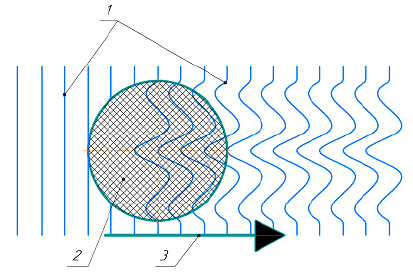Research
, Volume: 11( 3) DOI: 10.37532/2320-6756.2023.11(3).332The simplest model of the physical structure of the Universe, which can be verified experimentally.
- *Correspondence:
- Vasily Brusko
Independent researcher, Engineer, Chelyabinsk, Russia
E-mail: vbrusko@mail.ru
Received date: 13-February-2023, Manuscript No. tspa-23-89299; Editor assigned: 15-February-2023, PreQC No. tspa-23-89299 (PQ); Reviewed: 22-February-2023, QC No. tspa-23-89299 (Q); Revised: 26-February-2023, Manuscript No. tspa-23-89299 (R); Published: 2-March-2023, DOI. 10.37532/2320-6756.2023.11(3).332
Citation: Brusko V. The Simplest Model of the Physical Structure of the Universe, which can be verified experimentally. J. Phys. Astron. 2023;11(3):332.
Abstract
The article describes a possible model for the formation of elementary particles of matter from energy. A hydrodynamic model featuring the possibility to keep volumetric vortices from disintegration into chaotic (thermal) motion of the fluid particles for unlimited time has been developed. The study has demonstrated that the vortices in the model have all the qualitative properties of elementary particles: they have an analog of spin, rest energy, create analogs of fields and forces, can freely move in the model fluid as in the void, have wave properties, etc. In addition, the model has a speed limit similar to the speed of light and analogs of space and time. The model can be tested experimentally.
Keywords
Universe; Vacuum; Energy; Matter; Mass; Spin; Field; Force; Waves; Speed of light; Space; Time
Introduction
Since ancient times, scientists have sought to understand the structure of our Universe, but a complete and consistent model of the formation and existence of our Universe has not yet been created. In all existing models there are ambiguities and contradictions that need to be resolved. I propose to consider the Universe as a mechanism that produces fundamental physical phenomena: elementary particles of matter, fields, forces, space, time and much more with all the interconnections between them. How should such a mechanism be arranged? Will it be more complicated, for example, an internal combustion engine or not?
What will happen if the development of a description of the device and operation of an internal combustion engine is entrusted to theoretical physicists and mathematicians? In addition, ask them to do this in terms and formulas used in modern articles on theoretical physics. Most likely we will receive documentation according to which not a single person will understand how an internal combustion engine works and works. But a good engineer, using only a verbal description and drawings, is able to explain to almost anyone the device and principles of operation of an internal combustion engine. Moreover, according to the description of the engineer, you can even create a working model of the engine.
Is our universe simpler than an internal combustion engine?
I do not think so. I believe that the creation of really working models (mechanisms) is not the task of theoretical physicists, but engineers who know the basics of physics well and are able to take into account the mutual influence of all parts of the mechanism (model). How should the Universe be arranged from the point of view of an engineer? If there is a Customer who needs to create another Universe similar to ours, what will an engineer-physicist do in this case instead of a theoretical physicist?
Stage one: The engineer will develop and agree the terms of reference with the Customer. These will specify the fundamental physical properties of the existing Universe which must be present in the new Universe. The set of fundamental physical properties of the Universe (confirmed by numerous experiments) for the engineer will be as follows:
• In the existing Universe, there is vacuum, energy, and matter. Vacuum is the medium where everything happens. Matter consists of elementary particles. Elementary particles are formed from energy (for example, in collisions of particles), and can be turned into energy again (in annihilation) [1]. Elementary particles of the matter: have spin, their own internal energy proportional to mass ( E = mc2 ), create fields and forces, freely move in vacuum, and have wave properties [2, 3].
• In the Universe, there is a limit of the speed of movement of any types of energy (interactions). We call this limitation “the speed of light” [4].
• In the Universe, there is Space-as a possibility to determine the mutual position of elementary particles and various bodies relative to each other.
• There is Time in the Universe-as a possibility to determine the intervals between events.
• The universe is expanding.
Assume that the Customer agrees if the new Universe has all of the above properties, it would be suitable for him.
Stage two: The engineer will develop a draft design (principal model) of the new Universe. Suppose that, as a basis for the draft, the engineer will adopt two ideas from James Clerk Maxwell about the vortex structure of elementary particles of matter in material substance, the Ether.
Idea number 1: “Whatever difficulties we may have in forming a consistent idea of the constitution of the ether, there can be no doubt that the interplanetary and interstellar spaces are not empty, but are occupied by a material substance or body, which is certainly the largest, and probably the most uniform body of which we have any knowledge”. Maxwell, James Clerk (1878) “Ether,” Encyclopedia Britannica Ninth Edition, 8.
We assume that the media suitable for creation of matter in it (Universe) is an ideal fluid. The fluid is without internal friction, consisting of the particles of spherical shape with absolute elasticity. Assume that the particles of this fluid have a property that we call mass or inertia. Elastic properties of the fluid must be such that the longitudinal waves in it propagate at the speed of light.
Idea number 2: Elementary particles are the vortices of our ideal fluid. However, according to Maxwell, “No theory of the constitution of the ether has yet been invented which will account for such a system of molecular vortices being maintained for an indefinite time without their energy being gradually dissipated into that irregular agitation of the medium which, in ordinary media, is called heat”. Maxwell, James Clerk (1878) “Ether,” Encyclopædia Britannica Ninth Edition, 8: 568-572.
The engineer needs to make up (invent) a mechanism for conservation of vortices. The vortices can be created by injecting the same fluid with high (explosive) velocity into our ideal fluid. FIG.1 Laminar flow (no vortices) of such stream is impossible. The stream of the fluid will break into separate vortices. First into big ones, then these vortices will be divided into smaller vortices, then even smaller, and so on until the energy of the stream (explosion) is completely dispersed into the chaotic motion of fluid particles.
Figure 1: Model of vortex creation in a liquid. 1-fluid, 2-injected fluid, 3-area of the fluid turbulent motion.
Is there a way to keep the vortices in the fluid from dissipating into the thermal (chaotic) motion of particles of this liquid? Yes, there is!
Let’s place in the volume of our fluid, as it is roughly illustrated in FIG. 2, some sources of periodic longitudinal waves (FIG. 2 illustrates only four sources, more may be needed) [5]. Let the longitudinal waves from all sources fill the volume A. What happens if in the volume A we create vortices just like described above? (FIG. 1) How will the vortices and waves interact?
Figure 2: Longitudinal wave model of vortex maintaining 1-sources (generators) of longitudinal waves, 2-fronts of longitudinal waves, A-model area, 3-energy release (explosion).
With a certain number of wave sources, their location, amplitude, length, and frequency of the waves, the interaction between the vortex and the longitudinal waves will be similar to the following case: assume we have an absolutely empty polyhedron container, and its walls are made of material with absolute elasticity. Into the internal volume of this container, we throw several balls with absolute elasticity. FIG. 3 (illustrates the cross-section of a cavity with one ball). The hole, through which the balls will be thrown in, is quickly closed with a cover with absolute elasticity. In such conditions, the balls will bounce off the walls and from each other forever. And they will always keep moving inside the container.
Figure 3: Vortex maintaining diagram. 1-Ball with absolute elasticity, 2-Walls of the container with absolute elasticity.
There are gaps between adjacent longitudinal waves which we call the wavelength. Longitudinal waves, which move from different directions from different sources, can form similarities to the above-described multi-faceted container with their fronts. Suitable vortices fall into these energy containers. The effects of the energy of the “impacts” of the waves on the fluid particles in the vortex will be similar to the effects of the walls with absolute elasticity of the above container on the balls. The longitudinal waves are capable of blocking the vortex motion of the fluid particles in the “energy container” they have formed and will preserve the cyclical motion of the vortex particles. At the same time, the entire system will remain in the energy equilibrium state, without disintegrating the vortices to chaotic (thermal) motion of the fluid particles. Let’s call such a mechanism of vortex conservation the “longitudinal wave model of the physical universe” or the “new universe draft design” [6].
Stage three: Draft design (universe longitudinal wave model) defense.
Will the longitudinal wave model have the properties stated in the terms of reference?
• The vortex in the model fluid is formed from energy and can theoretically be converted to some other form of energy. This is what makes the vortex similar to a real elementary particle.
• Inside the vortex, there is a constant cyclic motion of the fluid particles. Each particle inside the vortex has its own momentum. Therefore, the vortex has its own, aggregated, internal angular momentum. Cyclic motion inside the vortex is preserved due to the “impacts” (energy quanta) of longitudinal waves, and therefore has a quantum nature. All this in aggregate is an analog of the spin of a real elementary particle.
• Vortex is the kinetic energy (motion) of the fluid particles localized in a certain volume. The energy of rotation (cyclic motion) of a vortex and various bodies is determined as the total energy of the elementary volumes of the bodies (fluid particles) using the generalized formula E= kmv2 . Where m= mass, v =speed, k =body shape factor. This formula is similar to the formula determining the internal energy of rest of real elementary particles E =mc2 , where c=speed of light, m=mass of elementary particle, k=1)
• By virtue of the energy superposition property, the longitudinal waves in the model must pass through each other and through the vortices and move on [7]. Assume that before interacting with the vortex, the front of a longitudinal wave was flat. Will it remain the same after passing through the vortex? Of course not!
Inside the vortex, there is a vector addition of the velocities of the fluid particles caused by the longitudinal wave and the vortex motion. The energy of the wave after passage of the vortex will not change. However, the distribution of energy in the wave will. FIG. 4 roughly illustrates that. Each vortex in the model will be surrounded by the region of the longitudinal waves, and the energy distribution in them will differ from the distribution of this energy in the vortex-free region of the model. It is obvious that the bulk density of these changes in the energy distribution will decrease in proportion to the distance from the center of the vortex. This phenomenon in the model is similar to the fields created by real elementary particles [8].
Figure 4: Field creation diagram. 1-one of the longitudinal wave streams, 2-region of cyclic motion of the fluid particles (vortex), 3-waves stream motion direction.
• What happens when two vortices come together? FIG. 5.
For simplicity, the figure illustrates only two counter flows of the waves. Due to the change in the energy distribution of the waves, after they pass the vortices according to cl. 4, in the interval between closely spaced vortices, the total energy of the waves may be greater or less than the energy of the waves outside. To be in the energy equilibrium position, the vortices in the model must take a certain position relative to each other (to come closer or to go apart). Such behavior of the vortices is an analog of the forces. There may be several equilibrium positions between the vortices. This probably explains the presence of several types of forces (electromagnetic, nuclear, and weak). The analog of the gravity in the model is the cumulative effect of huge clusters of the vortices (elementary particles) which manifests itself as the ability to create a shortage of wave energy between such clusters [8].
• In the model, the fluid particles themselves do not experience large displacements. Only the energy of the fluid (vortices and waves) moves over long distances. The vortices move involving the fluid particles in front of themselves into the vortex motion and free the particles behind them from the vortex motion. Is there any resistance when moving energy in our ideal fluid? Of course not. The model fluid is not capable of resisting the motion of the vortices and waves in it. Therefore, the vortices will behave in the fluid as real particles behave in the vacuum. The fluid will also be the basis of their existence for them and the “void” that does not interfere with the motion. It seems that we exist in a very dense and elastic "void". A ether wind, which would affect the particle agitation, does not exist [9].
• When the vortices are moving in the fluid, they are exposed to “impacts” of the longitudinal waves. The distribution of the energy of these “impacts” affects the trajectory of each vortex movement. If you change the energy distribution of the longitudinal waves, using the diffraction grating, for example, then when passing through the region of such changes, the vortex will change the trajectory of its motion. Under the action of the longitudinal waves, which are deformed by the diffraction grating, the vortex itself will be forced to exhibit the wave properties when moving.
• The longitudinal waves keep the vortex in some volume. This volume will not have clear boundaries and dimensions. The boundaries of this volume will constantly change within the distance between adjacent waves. Uncertainty of the form and occupied volume is one of the properties of the real elementary particles.
• In the new Universe model, we only have the fluid and various energy formations (waves and vortices) in it. The entire experience in studying of such systems suggests that the highest rate of energy transfer (impacts) in such a system is the speed of the longitudinal wave’s motion. Nothing can move faster. And this is the insuperable speed limit, the speed of light, pure and simple.
• The Longitudinal waves fill the entire volume of the model. The waves have the following characteristics: amplitude, wavelength, and wave frequency. The amplitude of the wave forms a quantum of energy. The wavelength (distance between adjacent waves) can serve as the smallest segments (quanta) to determine the distances between particles and bodies, and therefore they are capable of forming such a fundamental physical phenomenon, the space [10]. The frequency of the waves can serve as the smallest intervals (quanta) to determine the intervals between all other events, and therefore can form a fundamental physical phenomenon, the time [11].
• Our new Universe will be expanding. It is easy to see if you introduce a colored water jet into a large volume of clear water at high velocity.
• The only thing we need is to select the amplitude, frequency, and wavelength at which two vortices will form at once, similar to the proton and electron in a hydrogen atom.
To confirm the properties of the model, it is possible to conduct an experiment in a large volume of very transparent water FIG. 2. Installation of compression wave generators. Fill a certain volume of water with wave compression flows and make an explosive injection of colored water into the center of this volume. This may make it possible to confirm the possibility of the formation and long-term existence of the vortices described above.
Based on the longitudinal-wave model of the physical universe, it is possible to develop a computer simulation of the universe. The smallest independent body of such model must be represented by each absolutely elastic particle comprising our perfect fluid. The program must allow such values to be varied as the number of compressional wave flows, their amplitude (energy), wave run period, wave length, sizes of the particles our experimental medium consists of, and other conditions. The possibility of setting different conditions of energy release (explosion) must be provided, as well as the possibility of tracking and recording the way the vortices described above are formed. I suppose, that it will be possible to determine the conditions under which virtual elementary particles - vortices - will occur, and such particles will be absolutely similar to real elementary particles.
We may create a piece of virtual physical space which is absolutely equivalent to the real world. In this program, any possible virtual elementary particles can be created and collided. Such particles may be assigned any kinetic energy at any rate; and we should be able so study in great detail the results of the collisions of the virtual elementary particles.
At least several compressional waves participate in the formation of each virtual elementary particle (vortex). There may be a large number of the model medium particles in each compressional wave coverage area. The occurrence and existence of the vortices in the CW model and the final result of the vortex collision is formed as an overall result of numerous simple, very small interactions among a large number of virtual medium particles. We will never be able to predict the results of the virtual experiment using formulas and equations. However, these results may be completely simulated and calculated using a computer, and they will correspond to the behavior of real processes. Such a program may replace elementary particle accelerators (colliders) and other expensive physical devices. The development of such software will result in significant cost savings and will advance the knowledge of real-world physics.
Conclusions
Vacuum (emptiness) is the only material substance of the Universe (super dense and super elastic liquid). What we consider to be matter (elementary particles, bodies, planets, stars and ourselves) is vacuum energy arranged in various ways. The draft design (longitudinal wave model) satisfies all the requirements set out in the terms of reference.
This model can and should be tested experimentally.
Detailed design of the universe has yet to be created. However, with high probability, our already existing Universe is fundamentally arranged similarly to the model described above. It seems that the engineer will be able to satisfy the needs of the Customer and create a Universe that is physically similar to the existing one. If the Customer provides the necessary time, materials, and tools.
References
- Kittel C. Mechanics Berkeley Physics Course Vol 1. Tata Macgrawhill Publishing Company; 1965.
- Charles Kittel, Walter D. Knight, Malvin A. Ruderman, et al, Berkeley Physics Course 1, Mechanics, National Science Foundation, McGraw-Hill Book Company, 1965:214.
[Google Scholar] [Crossref]
- Charles Kittel, Walter D. Knight, Malvin A. Ruderman, et al, Berkeley Physics Course 1, Mechanics, National Science Foundation, McGraw-Hill Book Company, 1965:408. [Google Scholar] [Crossref]
- Charles Kittel, Walter D. Knight, Malvin A. Ruderman, et al, Berkeley Physics Course 1, Mechanics, National Science Foundation, McGraw-Hill Book Company, 1965:331. [Google Scholar] [Crossref]
- Crawford FS. Berkeley physics course: Waves. New York, NY, USA: McGraw-Hill; 1968.
[Google Scholar] [Crossref]
- Johnson RE. A critical review of research on personal values, 1990–2000: Implications for pastoral counselors. Alliant International University, San Diego; 2001.
[Google Scholar] [Crossref]
- Charles Kittel, Walter D. Knight, Malvin A. Ruderman, et al, Berkeley Physics Course 1, Mechanics, National Science Foundation, McGraw-Hill Book Company, 1965:480. [Google Scholar] [Crossref]
- Feynman RP, Leighton RB, Sands M. The Feynman lectures on physics, Vol. I: The new millennium edition: mainly mechanics, radiation, and heat. Basic books; 2011.
[Google Scholar] [Crossref]
- Garoz A. The Possibility of Time Travel through Einstein’s Special Relativity Theory.
[Google Scholar] [Crossref]
- Feynman RP, Leighton RB, Sands M. The feynman lectures on physics; vol. i. Am. J. Phys. 1965;33(9):750-2.
- Feynman RP, Leighton RB, Sands M. Feynman Lectures on Physics. Vol.1. Mainly mechanics, radiation, and heat, Addison-Wesley Publishing Company Inc. 1964:86-9.
[Google Scholar] [Crossref]






